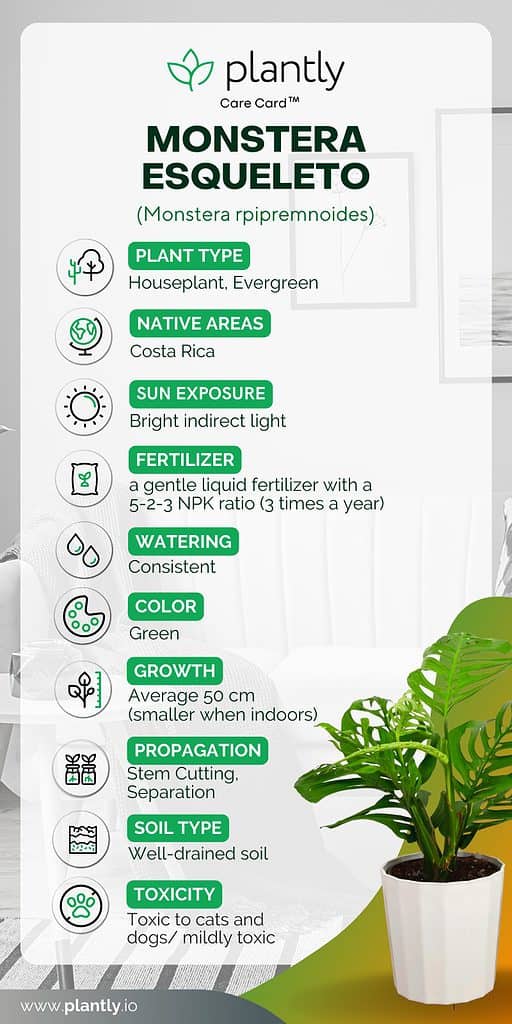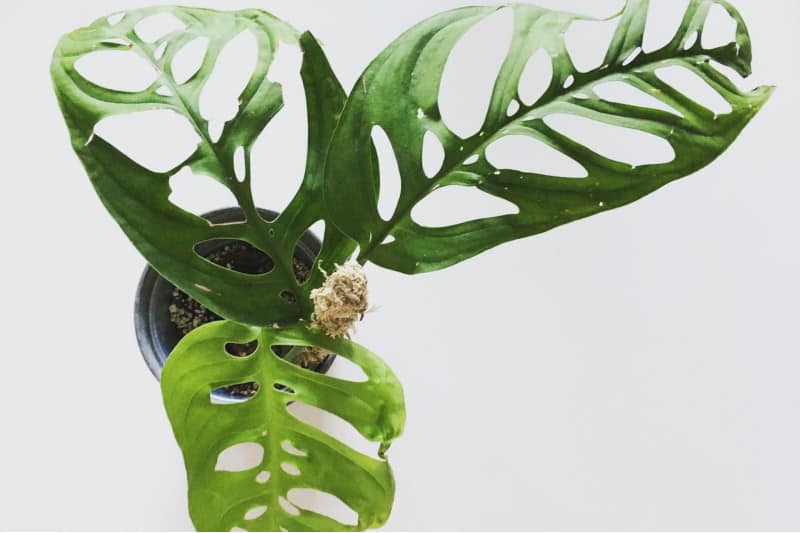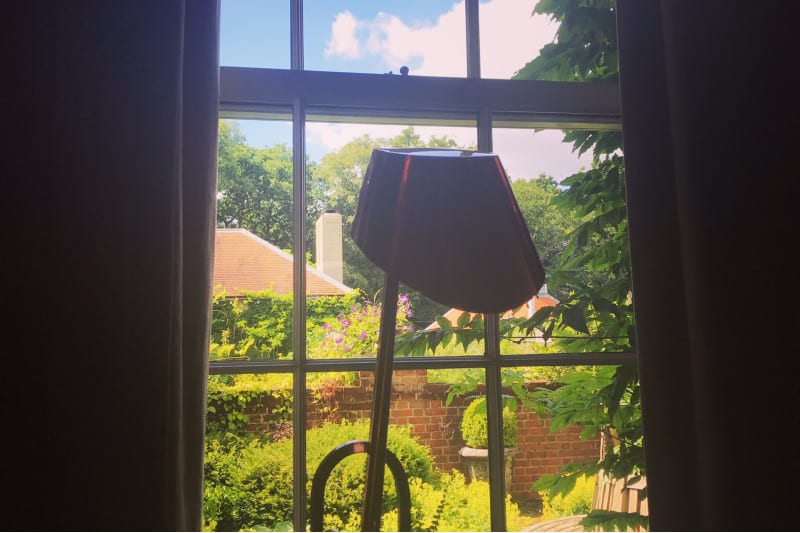No products in the cart.
Table of Contents
Native to the cloud forest of Costa Rica, Monstera esqueleto, also known as Monstera epipremnoides, is a tropical plant that is growable indoors. These kinds of plants are known to have unique fenestrated leaves that allow them to survive heavy rain and wind.
But do you know what makes Esqueleto stand out? Well, it has bigger leaves than its famous Monstera obliqua and Monstera adansonii. This plant forms spadix, or inflorescence flower but its fruit, though a berry type, is not edible.
Since this plant is also being added up to Philodendron collections, it also has a whole lot of different siblings that may complement your tropical collection. However, Monstera epipremnoides is one of the cheapest, easy-to-maintain types of Monstera.
Ready for your tropical plant adventure? Keep scrolling for Monstera Epipremnoides care tips!

Monstera Esqueleto Plant Care Basics

Plant care for Monstera epipremnoides is a step up from many other monstera species, such as the tough and showy Monstera deliciosa or the easygoing and fast-growing Monstera adansonii.
This plant, on the other hand, will reward you with plenty of lovely, finely fenestrated leaves that will lend a subtle tropical aspect to any environment if you’re up for it.
It may become the jewel in your houseplant collection!
What’s the best soil mix?
To avoid overwatering and the issues that come with it, make sure your plant has proper drainage. Drainage is heavily affected by the soil mix structure and texture. So, pay attention to it. Choose a light and loamy variety. Maintain a pH of 5.5 to 7.
Since this is a rare plant, Monstera epipremnoides is such a significant investment, it is highly recommended to invest in high-quality soil to ensure that it survives. It’s best to use a nice aroid soil mix. Pine bark, perlite, coco coir, and other portions of a decent potting mix are commonly used in aroid soil mixes.
Use double the amount of pine bark compared to the other soil mixture elements to provide better aeration. This plant prefers damp soil with a high organic matter content.
How much water does it need?
Monstera epipremnoides, like other monstera plants, thrive in evenly moist soil. So, water when the top two inches of soil feel dry to the touch. You can also use a moisture meter to have a better understanding of what’s going on deeper in the plant pot.
There are chances when the top of your soil can dry up while the root ball is thoroughly saturated! Don’t be deceived!
Water once a week, making sure the soil is just barely damp before watering again. If the soil is still moist and slightly damp, do not water it since soggy soil causes root rot over time.
When watering Monstera epipremnoides, make sure the water is flowing through the soil mixture and a large portion of the water is coming out of the pot right away.
This is a good sign that the soil is sufficiently draining.
What light condition is preferred?
Indirect light is what Monstera epipremnoides needs. This plant receives dappled sunlight in its natural habitat. Position your Monstera epipremnoides in a location with plenty of bright, indirect sunlight but no direct sunlight after 10:00 a.m.
It usually implies a few feet away from a west- or south-facing window in the Northern Hemisphere.

A few feet from a north-facing window can work in the Southern Hemisphere, but you should avoid south-facing windows. It can withstand direct sunshine, but only for a maximum of 2-6 hours at a time, as any longer may cause the leaves to burn.
Your plant may be getting too much light if the leaves are faded or dried out.
What’s the best temperature and humidity level?
Temperatures of 70-80oF (21 to 27oC) are ideal for Monstera epipremnoides. Temperatures in the high 60s are acceptable, but temperatures should not fall below 65oF (18oC) or increase above 85oF (29oC). Keep your plants away from drafts, heaters, air conditioning/heating vents, fireplaces, and other heat sources.
These can quickly freeze, scorch, or dry out delicate leaves! Because they naturally thrive at high heights, they may grow in mild to cold temperatures in nature.
Humidity is also important for the health of the leaves. Set up a humidifier near your plant, or at the very least place it on a pebble tray to increase humidity. This plant thrives in a steamy bathroom and loves frequent misting.
Monstera epipremnoides can thrive in terrariums if given adequate light and drainage. Another option, as always, is to group numerous houseplants together to create a humid microclimate. If your plant’s leaves appear dry and brittle, it’s a solid sign it needs more humidity.
Should I fertilize regularly?
To stimulate the development of lush foliage, strong stems, and a sturdy root system, Monstera epipremnoides require a steady supply of nutrients. However, we advise that you fertilize only when necessary. Use a diluted fertilizer three times a year, and pour it away from the plant’s base.
Many people advise decreasing or stopping fertilizing in the fall and winter. Although, some plant owners found that indoor plants rarely go into real dormancy because indoor temperatures are pretty steady.
Houseplants often grow in fits and start all year, rather than following the seasons of growth and dormancy. With that in mind, pay close attention to your plant’s growth habits. As long as you dilute the fertilizer properly, you should be able to fertilize at half or even full strength throughout the fall and winter.
How do I multiply this plant?
Stem cuttings or separation are the easiest ways to propagate Monstera epipremnoides. Find a section with a few young, healthy leaves and a node, a bump on the stem opposite a leaf, to propagate with stem cuttings.
Then, cut below the node with clean scissors or shears to include it in your cutting. This is important because that node will give rise to the roots!
Place the cutting in a clean glass filled with water and keep it somewhere bright. Replace the water regularly and keep it topped up. You should start to see roots form in a few weeks.

Plant your cutting in soil when the roots are a few inches long and care for it like a mature plant. Unpot the plant and carefully disentangle the root ball to separate the plant into multiple smaller plants to propagate by separating.
You should plant each of these components separately in its own plants.
Will it grow in my area?
If you live in areas under USDA hardiness zones from 9b -11, then you can grow this plant without much trouble.
In our perspective, Monstera epipremnoides is a slow grower that produces around one leaf each month in indoor growing circumstances. However, the leaves are enormous and stunning, and the wait was well worth it.
Monstera epipremnoides, like M. adansonii and M. deliciosa, is a climber that will benefit from a totem or moss pole to which it can eventually connect its aerial roots.
How do I repot Monstera epipremnoides?
Pick a good, clean pot that is 2-3 inches larger than the root ball of your plant. This will allow it to expand without retaining more water than your plant can use.
Check for drainage holes in your pot! If you fall in love with a beautiful planter that doesn’t have drainage holes, you can put your plant in an inexpensive grower’s pot and place it inside the attractive planter.
When it’s time to water, simply take out the inner pot, water the plant, and drain the pot before reinstalling it in the beautiful planter. Clay pots don’t work well because these plants require a lot of soil, and the porous material of the clay pots dries out the substrate too quickly.
Some plant owners use plastic pots with drainage holes, which appear to perform well in retaining humidity in the soil for more extended periods.
Is pruning necessary?
It may be necessary to prune a Monstera epipremnoides from time to time if it is allowed to crawl and climb. Take it easy because this plant grows slowly, and the leaves take a long time to mature. You’ll simply need to remove any damaged, yellowed, or dead leaves in the best-case scenario.
Always cut near the main stem as possible with a sterile and sharp pruning knife or set of scissors.
Monstera Esqueleto Varieties and Similar Plants
As mentioned, Monstera epipremnoides has various types of siblings that can be an addition to your tropical plant collection. Aside from its well-known siblings, Monstera obliqua and Monstera adansonii, there are also some known Monsteras such as:
- Monstera deliciosa
- Monstera dubia
- Monstera acuminata
- Monstera Thai Constellation
- Monstera borsigniana
- Monstera standleyana
- Monstera siltepecana
- Monstera pinatipartita
- Monstera kartenianum
Monstera Esqueleto Diseases & Pests
There are three common plant diseases that may prevent your Monstera epipremnoides growth:
Yellow Leaves
Yellowing of leaves happens when your plant receives an excessive amount of water and/or sunlight. M. esqueleto never liked very wet soil, simply changing your watering schedule is enough to prevent your plant from dying.
If too much love from the sunlight is the reason, transfer your plant to a different spot that is not very direct to sunlight.
Cut the yellow leaves especially when it’s already dry and dead.
Brown Leaf Edges
This happens when your plant is either still receiving too much sunlight or the air in its location is too dry. Since Monstera epipremnoides are used in a humid environment, they have to be placed in a highly humid area of your house. Turning on your humidifier could be such a great help.
Simply trim the brown edges of the leaves for them to regrow fresh green leaves.
Root Rot
When your plant is receiving too much water, root rot is possible. Reschedule watering your M. esqueleto especially during winter. When the weather is cold, it doesn’t need frequent watering.
Removing the rotten part of the plant’s root may save your M. esqueleto. It is recommended, but not really required, to plant it in new potting soil to avoid the fungus and bacteria that may have grown where the rotting started.
Fungal Problems
Fungak problems are very rare but can happen, only if your plant is not taken good care of. Fungicides are the best way to remove them, but I’m pretty sure this won’t happen to your Esqueleto.
Pests
Though Monstera epipremnoides rarely attract houseplant pests, there can be spider mites, and scale visits especially when caring for it is not consistent. These common houseplant pests are easy to remove with water and some soap solution, or rubbing with a cotton ball soaked with alcohol.
Frequently Asked Questions
Monstera epipremnoides, is the larger sibling of Monstera adansonii, with larger but still fenestrated leaves than the typical Monstera adansonii. These holes occupy a substantially larger portion of the leaf and are more even and symmetrical than the M. adansonii’s. The size, color, and texture of the leaves, as well as the fenestration pattern, distinguish Monstera epipremnoides from Monstera adansonii. Finally, the fenestration pattern can be used to distinguish between the two. On adansonii leaves, holes are smaller and more oval-shaped, and they don’t always appear in a tidy pattern; instead, they appear all over the leaf.
There are studies that show Monstera epipremnoides is toxic to pet cats and dogs when its leaves are ingested. The sap is known to have toxic chemicals that cause hypersensitivity and dermatitis.
According to NASA, every 100 square feet of space should have one air-purifying plant. Large-leafed plants, such as the fashionable monstera plant, have been proved to be one of the most effective in reducing pollutants.
Growing a rare Monstera Epipremnoides plant is not easy but if you’re confident enough to grow your own Monstera Epipremnoides, you can check here at Plantly. You can see lots of plants there that might add up to your home decoration. Enjoy!
Whether you want to buy, sell or simply reach out to other plant enthusiasts, Plantly is the right place to be!


